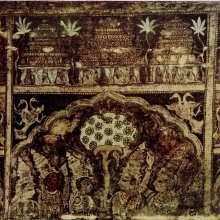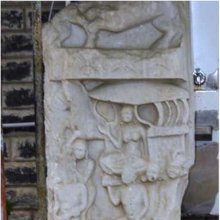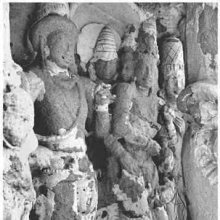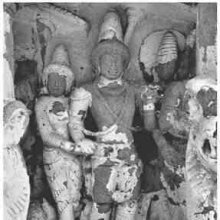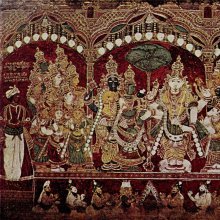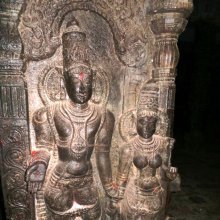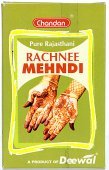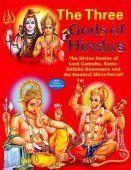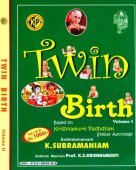Marriage: 3 definitions
Introduction:
Marriage means something in Hinduism, Sanskrit, the history of ancient India. If you want to know the exact meaning, history, etymology or English translation of this term then check out the descriptions on this page. Add your comment or reference to a book if you want to contribute to this summary article.
Images (photo gallery)
(+15 more images available)
In Hinduism
Natyashastra (theatrics and dramaturgy)
Source: Shodhganga: Elements of Art and Architecture in the Trtiyakhanda of the Visnudharmottarapurana (natya)Marriage is associated with Khaṭakāvardhamāna-hasta: one of the thirteen Combined-hand Gestures (in Indian Dramas) (known as saṃyuktahastas), according to the Viṣṇudharmottarapurāṇa, an ancient Sanskrit text which (being encyclopedic in nature) deals with a variety of cultural topics such as arts, architecture, music, grammar and astronomy.—The word khaṭakāvardhamāna is an amalgamation of two words viz., khaṭaka and vardhamāna. The word khaṭaka denotes a half closed hand and vardhamāna means increasing. In khaṭakāvardhamāna posture both of the hands are in khaṭaka position and one hand is placed upon another. [...] According to the Abhinayadarpaṇa, this posture is used to denote coronation, worshipping, marriage etc.
Source: Shodhganga: Literary estimate of mudraraksasaMarriage is denoted by the Sanskrit term Vivāha, and should be avoided on a stage (where a dramatic play is performed).—A Nāṭaka should contain pañcasandhis which indicate five successive stages of the drama. This criterion also is present in the Mudrārākṣasa. [...] In the Sāhityadarpaṇa, Viśvanātha gives a list of certain actions which should not be presented on the stage. These are [e.g., Vivāha (marriage)] [...].

Natyashastra (नाट्यशास्त्र, nāṭyaśāstra) refers to both the ancient Indian tradition (shastra) of performing arts, (natya—theatrics, drama, dance, music), as well as the name of a Sanskrit work dealing with these subjects. It also teaches the rules for composing Dramatic plays (nataka), construction and performance of Theater, and Poetic works (kavya).
India history and geography
Source: Singhi Jain Series: Ratnaprabha-suri’s Kuvalayamala-katha (history)Marriage in ancient India (and associated festivities) are vividly depicted in the Kathās (narrative poems) such as Uddyotanasūri in his 8th-century Kuvalayamālā (a Prakrit Campū, similar to Kāvya poetry).—The Kuvalayamala (779 A.D.) is full of cultural material which gains in value because of the firm date of its composition. [...] Page 170.21 f.: Twenty-four items are mentioned in connection with the marriage of Kuvalayamālā [...]. Page 171.1 f.: There is a beautiful description of marriage festivities; and the author has chosen for it a new metre of the amṛtadhvani type carrying the last part of the foregoing stanza into the first part of the succeeding stanza 11.18 f.).

The history of India traces the identification of countries, villages, towns and other regions of India, as well as mythology, zoology, royal dynasties, rulers, tribes, local festivities and traditions and regional languages. Ancient India enjoyed religious freedom and encourages the path of Dharma, a concept common to Buddhism, Hinduism, and Jainism.
See also (Relevant definitions)
Ends with: Tree marriage.
Full-text (+3035): Vivaha, Kanyadana, Pariṇaya, Udvaha, Panigrahana, Durvivaha, Panipidana, Upayama, Vaivahika, Vadhukya, Paishacavivaha, Udvahika, Gandharvavivaha, Kanyapradana, Khataka, Prajapatya, Shulka, Daradhigamana, Pratijnavivahita, Navaradeva.
Relevant text
Search found 256 books and stories containing Marriage; (plurals include: Marriages). You can also click to the full overview containing English textual excerpts. Below are direct links for the most relevant articles:
The Markandeya Purana (Study) (by Chandamita Bhattacharya)
Intercaste Marriage < [Chapter 2]
Marriage (a): Monogamy < [Chapter 2]
Historical Elements in the Matsya Purana (by Chaitali Kadia)
Prostitution in the Matsya Purāṇa < [Chapter 5 - Cultural history in the Matsya-Purāṇa]
Lineages of Viśvāmitra < [Chapter 6 - Human history in the Matsya-Purāṇa]
Lineages of Atri < [Chapter 6 - Human history in the Matsya-Purāṇa]
Child-Brides in R. K. Narayan’s Fiction < [July – September, 2005]
Hindu Law Reform < [October 1951]
The First Widow Marriage < [October 1970]
A Happy Married Life (by Venerable K. Sri Dhammananda)
Part 9 - The East And The West
Sense Of Insecurity < [Part 5 - Security, Respect And Responsibilities]
Manusmriti with the Commentary of Medhatithi (by Ganganatha Jha)
Verse 3.42 < [Section IV - The Eight Forms of Marriage]
Verse 3.20 < [Section IV - The Eight Forms of Marriage]
Verse 1.112 < [Section LXII - Contents of the Treatise]
Kamashastra Discourse (Life in Ancient India) (by Nidheesh Kannan B.)
6.2. Marriage in Ancient India < [Chapter 5 - Looking for Alternatives: Possibilities in Kāmaśāstra]
4.1. Summary of Kāma-sūtra Book 3: Kanyā-samprayuktaka < [Chapter 3 - A Thematic Analysis of Vātsyāyanakāmasūtra]
4.1. Summary of Kāma-sūtra Book 7: Aupaniṣadika < [Chapter 3 - A Thematic Analysis of Vātsyāyanakāmasūtra]
Related products
(+8 more products available)
